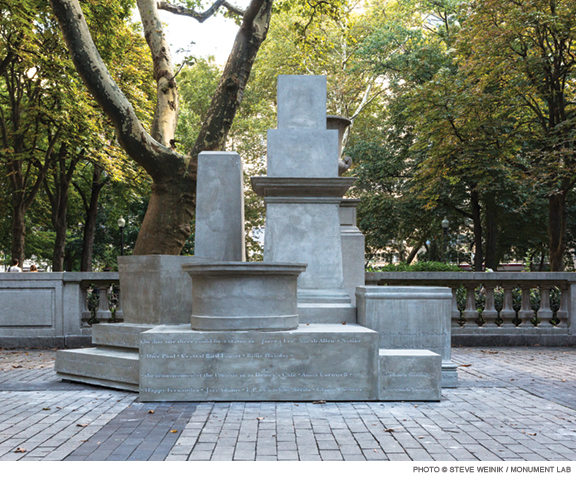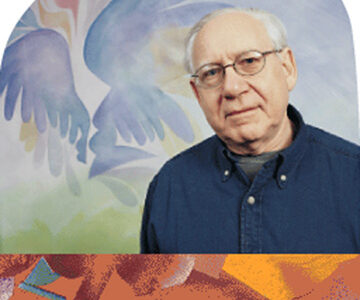
What kinds of public monuments can evoke our better angels?
It’s hard to say which American tradition goes back further: erecting public monuments or destroying them. The story of outdoor public sculpture in the US often begins with William Rush, whose figurative carvings enlivened Philadelphia in the early 1800s, including a likeness of George Washington that once stood in Independence Hall. His reputed masterpiece, a statue of the Crucifixion for Philadelphia’s St. Augustine’s Church, completed in 1810, was destroyed (along with the rest of the church) by anti-Catholic rioters 34 years later. Yet America’s history of monument-obliteration goes at least as far back as 1776, when Manhattanites toppled a statue of Britain’s King George III and melted it down for musket balls.
It’s also hard to think of a time when conflict over monuments has been sharper than the middle months of 2020. Arguments about the scope and import of contemporary injustices have touched off heated debate—and action—about which of our historical figures merit continued veneration in public spaces at public expense. And though waves of criticism (and defense) have lapped up against pedestals of many sorts, they have crashed most intensely against the roughly 2,000 monuments to the Confederacy that were mostly erected after Reconstruction gave way to the mass disenfranchisement and oppression of Black Americans under Jim Crow regimes.
“These statues celebrate a false history that romanticizes those that actually participated in a treasonous rebellion against our country,” noted Patricia Wilson Aiden, CEO and president of the African American Museum in Philadelphia, in a September panel discussion hosted by Penn’s Arthur Ross Gallery. Their purpose, she suggested, was “to venerate the Confederacy and all it stood for,” not least “the subservience of Black people”—whose brief enjoyment of civil and political rights in the decade after the Civil War prompted a racist backlash that would not begin to find legislative remedy until the 1960s.
The virtual symposium sought to address a question that’s easy to state but thorny to solve. As Aiden put it: “How do we use public art such as statues to preserve our history and memorialize our shared American ideals?”
We might start by bearing in mind that statues are not synonymous with history. “There’s often a false equation between the removal of a problematic statue and the elimination of history,” said Ken Lum, the Marilyn Jordan Taylor Presidential Professor and chair of fine arts at the Weitzman School of Design. “When the statue of Frank Rizzo was removed” from the plaza of Philadelphia’s Municipal Services Building, “that doesn’t mean that Frank Rizzo disappears from history. There’s all kinds of books on Philadelphia history, and all kinds of writings about Frank Rizzo. There’s a huge archive in City Hall about the tenure of Frank Rizzo—about his conduct and the decisions he made as a police chief and then subsequently as mayor. So it’s not as though history disappears when a statue of Frank Rizzo is removed.”
But the presence or absence of such monuments shapes our “collective memory”—that is, our determinations about which parts of our history count the most—said Randall F. Mason, a Penn associate professor of historic preservation [“Protecting ‘Negative Heritage’ in Rwanda,” Jan|Feb 2016]. When we are reckoning with these symbolic statues, “we are reckoning with them as works of art” and also “debating their visibility or invisibility.” And in Mason’s view, the reckoning underway now is working.
Public monuments provide a useful platform for the “fundamentally political” debates “about what is valuable—what cultures we want to make and create and pass on to future generations.” They may be shallow vessels for communicating the fullness of any particular historical figure or episode, but the way we interact with and make decisions about them can help us sort out what we wish to venerate about the past and what we hope to change.
After the 9/11 attacks, he noted, New Yorkers covered the George Washington statue in Union Square with American flags, photographs of victims, etched and spray-painted (and conflicting) slogans, and other artifacts that sought to place that traumatic moment in conversation with the past. This year the pedestal for a statue of Stonewall Jackson in Richmond, Virginia, was similarly “rescripted by the public” (albeit with considerably less reverence for the Confederate commander).
“This, to me, is good evidence that not only is the system working but that change is being embraced,” Mason said. “And we’re not just retreating to a settled, static, and complacent attitude that once an artwork is made it deserves to be conserved. Conservation and preservation are, like collective memory itself, a fraught process that is bound to be fought over, contested, and always have an uncertain result.”
One question that should guide these debates, Mason suggested, is: “What is an honest representation of the past, as opposed to giving too much deference to the representations that we’ve inherited?”
To which, of course, there is no single, static answer.
“We certainly need to strive always to be honest,” remarked David Brownlee, the Frances Shapiro-Weitzenhoffer Professor Emeritus of 19th Century European Art. “But one of the things that entails is recognizing that our honesty of today may not be the same thing as the honesty of tomorrow.
“The reality is, of course, that monuments throughout history have been destroyed, have been repurposed, have been obliterated,” he said. And societies are constantly reappraising their pasts in light of the present.
Brownlee reflected on how frequently monuments fail to provoke very much thought or feeling at all. When tens of thousands of Philadelphians demonstrated peacefully for racial justice on May 30 on the Benjamin Franklin Parkway, he remarked, they were not moved to celebrate Hermon Atkins MacNeil’s memorial to soldiers who defeated the Confederacy, nor to cheer J. Otto Schweizer’s All Wars Memorial to Colored Soldiers and Sailors in Logan Square. That attention was reserved for the statue of Frank Rizzo, who is remembered by present Philadelphians as (among other things) a no-holds-barred police chief and opponent of school desegregation who campaigned for mayor on the slogan “Vote White.”
“I suppose,” Brownlee said in a dismissive appraisal of the statue itself, “that we should be grateful that the artistic case for evil was made with such banality. But it does make one yearn for a place where great art inspires us to rally in support of our ideals, not to protest our afflictions.”
The US is blessed with some monuments that have the capacity to evoke emotion and inspire reflection about our civic life, he said, citing the Lincoln Memorial and Vietnam Veterans Memorial in Washington. But the truth is that “making art that really changes how we think, about anything, is hard.”
It can be especially hard in the context of public monuments, said Sharon Hayes, a professor of fine arts at the Weitzman School, because both figurative art and textual summary tend to whittle complex stories down to simplistic nubs. This is not just the case for statues of horse-mounted generals whose battlefield fates were shaped by foot-soldiers left out of the frame. It’s evident even in memorial plaques like the one honoring the Quaker abolitionist Lucretia Mott for organizing the Philadelphia Female Anti-Slavery Society. “The Society was founded by about 18 women,” Hayes remarked, “and many of them were members of the free Black community.” But the “genre of the monument”—or in this case commemorative plaque of standard dimensions that are a common sight in Philadelphia—arguably does as much to shrink our understanding of history as to deepen it.
For that and other reasons, Brownlee suggested, maybe Americans today “should be thinking of other kinds of monuments—monuments that are less expensive, that are less permanent perhaps, and most importantly, monuments that are not about singular individuals, but that are about places or collectives of people, that can enrich and broaden our story.”
Brownlee cited Hayes’ own 2017 temporary installation in Philadelphia’s Rittenhouse Square, an assemblage of unoccupied pedestals bearing inscriptions designed to coax viewers into contemplating historic figures who have been neglected by traditional monuments—in this case, Philadelphia women as widely acclaimed as Billie Holiday and as overlooked as Adele Goldstine and Crystal Bird Fauset. (If those names itch your Google finger, that’s the point. The former was a mathematician who wrote the first programs as well as the manual for ENIAC, the first electronic digital computer; the latter was the first female African American state legislator to be elected in the US.)
Brownlee also singled out New York’s “Tribute in Light,” a public-art installation featuring light beams projected skyward from the World Trade Center plaza. What was intended as a temporary tribute to the victims of 9/11 “has become a permanently recurring installation of evanescent forms that remember the evanescence of what we once imagined to be permanent.”
If the purpose of art is to provoke fresh ways of seeing and thinking, our public monuments should aim no lower.
“I don’t believe we need more men and horses on pedestals,” Brownlee said. “Or even women on pedestals. We need monumental art that speaks the language of our time. Art that is like Hamilton and not Pirates of Penzance.
“Most of the public art we have is a reflection of what we believe,” he added. “It is evidence of what we believe—or what we believed at a particular time. It is not change-making, but status-preserving work. And I think the challenge to artists is to create things that change the way people think, not that simply reinforce the way that they think already.” —TP





Thanks for such great contextualization of public art during such complex times.